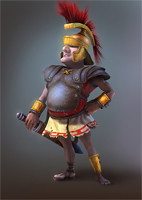
Spot has read a couple of the reviews of the movie "300," the new spear and sandal extravaganza about the Greek and Persian dustup at Thermopylae, including this one:
This much we know is true: 300 has more style than a P. Diddy garage sale. Brimming with nudity, fluidity, and gleefully excessive violent stupidity, 300 is all sizzle and no steak, a one page outline masquerading as a two hour movie (trust us, that's a compliment). All style with an almost boyish glee to the proceedings, Snyder & Miller's 300 is a man's movie about the culture of being men, war, pride, and all that other manly man stuff. Did I mention this movie's about war? Some of the rhetoric is so war-thirsty, it's surprising the movie wasn't followed by "I'm George W. Bush, and I approved this message." Seriously, can you tell the difference between this line and a Bush stump speech: "Freedom isn't free at all. It comes with the cost of blood." The script consists of a bunch of elevated language all saying the same things ("respect and honor," "Spartans are real men," etc.) while marking time until the next hyper-stylized battle sequence. Not that viewers came to this movie expecting Billy Shakes(peare) but a plot would've been nice.
Or this one from the New York Times:
"300" is about as violent as "Apocalypto" and twice as stupid. Adapted from a graphic novel by Frank Miller and Lynn Varley, it offers up a bombastic spectacle of honor and betrayal, rendered in images that might have been airbrushed onto a customized van sometime in the late 1970s. The basic story is a good deal older. It's all about the ancient Battle of Thermopylae, which unfolded at a narrow pass on the coast of Greece whose name translates as Hot Gates.
Hot Gates, indeed! Devotees of the pectoral, deltoid and other fine muscle groups will find much to savor as King Leonidas (Gerard Butler) leads 300 prime Spartan porterhouses into battle against Persian forces commanded by Xerxes (Rodrigo Santoro), a decadent self-proclaimed deity who wants, as all good movie villains do, to rule the world.
The Persians, pioneers in the art of facial piercing, have vastly greater numbers — including ninjas, dervishes, elephants, a charging rhino and an angry bald giant — but the Spartans clearly have superior health clubs and electrolysis facilities.
The reviews remind Spotty of the time he went with his pups to the "new" Planet of the Apes move, starring of course Charlton Heston, but this time as an ape. As we were walking out to the car after the screening, Spot asked his pups what they thought of the movie. One of the pups responded, "A giant monkey clunker." Indeed.
After reading these reviews of "300," Spot had a thought: Victor Davis Hanson has gotta love this one. And guess what, boys and girls, he does:
But most importantly, 300 preserves the spirit of the Thermopylae story. The Spartans, quoting lines known from Herodotus and themes from the lyric poets, profess unswerving loyalty to a free Greece. They will never kow-tow to the Persians, preferring to die on their feet than live on their knees.
If critics think that 300 reduces and simplifies the meaning of Thermopylae into freedom versus tyranny, they should reread carefully ancient accounts and then blame Herodotus, Plutarch, and Diodorus — who long ago boasted that Greek freedom was on trial against Persian autocracy, free men in superior fashion dying for their liberty, their enslaved enemies being whipped to enslave others.
Remember, boys and girls, "300" was "inspired" by a comic book:
So the film is indeed inspired by the comic book; and in some sense its muscular warriors, virtual reality sets, and computer-generated landscapes recall the look and feel of Robert Rodriquez's screen version of Sin City. Yet the collaboration of Director Zack Snyder and screenwriters Kurt Johnstad and Michael Gordon is much more of a hybrid, since the script, dialogue, cinematography, and acting all recall scenes of the battle right from Herodotus's account.
300, of course, makes plenty of allowance for popular tastes, changing and expanding the story to meet the protocols of the comic book genre. The film was not shot on location outdoors, but in a studio using the so-called "digital backlot" technique of sometimes placing the actors against blue screens. The resulting realism is not that of the sun-soaked cliffs above the blue Aegean — Thermopylae remains spectacularly beautiful today — but of the eerie etchings of the comic book.
Spot wonders what Johnny Rocketseed thought of the movie. He'll have to check.
No comments:
Post a Comment